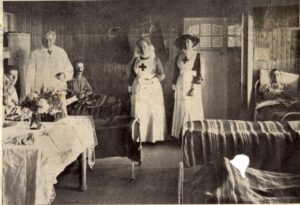 On 26th September 1914 the Bexhill Observer when reporting on Red Cross training, mentions for the first time that Sussex 38 Voluntary Aid Detachment are assisting the Medical Officer at Cooden camp, “where the pavilion has been fitted up as a temporary hospital”. This was Cooden Lawn Tennis Pavilion and at that time it contained only fourteen beds. This was not sufficient and a collection was soon organised to augment a Government grant.
On 26th September 1914 the Bexhill Observer when reporting on Red Cross training, mentions for the first time that Sussex 38 Voluntary Aid Detachment are assisting the Medical Officer at Cooden camp, “where the pavilion has been fitted up as a temporary hospital”. This was Cooden Lawn Tennis Pavilion and at that time it contained only fourteen beds. This was not sufficient and a collection was soon organised to augment a Government grant.
The extension, according to the Bexhill Chronicle of 18th December 1915, contained a ward with twenty-six beds, “bathrooms, kitchen, operating theatre, and nurses’ bedrooms” and, by November 1915, a recreation room. It remained in service until the 18th January 1919 when the Observer again marked the occasion stating “Readers will regret to hear that the Cooden V.A.D. Hospital is closed as of today (Saturday).”
Bexhill’s Support
The support the town provided, reported weekly in both local papers, (the Bexhill Observer and the Bexhill Chronicle), suggests a close and affectionate relationship had built up between the hospital and the towns people. In October 1915 the donation list thanked Miss Ellers for a billiard table, Mr and Mrs Herman Lohr for a piano, Mrs Morrison for slippers, Mrs Newton for blankets, Mrs Goldsmid for games as well as the usual vegetables, fruit, cakes, eggs, jam, cigarettes, and Rev. Martin-Johns gave malted milk. Mrs Allison’s collection box by her front gate contained macaroni, raisons, papers, books, pipes, handkerchiefs and chocolate.
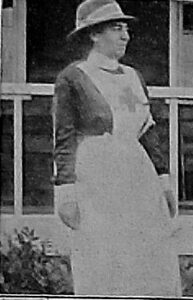 The Commandant
The Commandant
It is thought that Sussex 38 Commandant Miss N. H. Bennett was the daughter of an officer of the Golf Club, Charles Bennett, and was part of the social circle that included the Sackville family of Earl De La Warr and Lieutenant-Colonel C. Lowther, MP who recruited the Southdown Regiment battalions known as Lowther’s Lambs”. Miss Bennett may have had some nursing experience though whether as a qualified nurse is unclear. A Commandant was not necessarily a trained nurse.
The training camp and Hospital were quite isolated at that time and the Commandant had to ask for help to transport the nurses to work from Bexhill, before the nurse’s quarters were built. Miss Bennett was supported by the Matron, Miss Leng, and Miss Maud Blenkarn, the Superintendent. Miss Blenkarn, and V.A.D. nurses Miss U. Barrow, Miss E. Harris, Mrs G. Hill-Joseph and Miss C. Lancaster were reported in the Observer of 27th October 1917, to have been, “brought to the notice of the Secretary of State for valuable services rendered in connection with the War”.
The need to keep the men’s morale high and maintain their stamina induced the nurses to challenge them to a cricket match in September 1915, and the V.A.D.’s resultant sound defeat must have been just what the troops needed to raise their spirits. Private T. Stuart of the Liverpool Scottish had the highest score, 39, “with one hand only and that his left”, both local papers reported gleefully. Later local news reports and the absence of any evidence of a return match suggest that the patients found the men from the Camp offered better sport than the nurses!
MBEs for Willson and Bennett. 3rd April 1920 Observer
Patient Care Priorities.
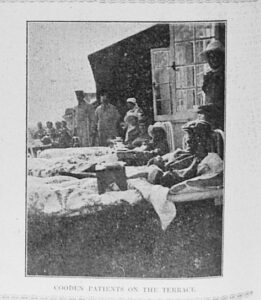 There was an operating theatre at Cooden Beach Hospital so nurses were looking after surgical wounds and assisting the surgeon during operations. It is likely that operations were usually planned, not emergencies. Patients would probably have come from Eastbourne Military Hospital, not straight from the front. We have no evidence for the level of seriousness of the operations or how ill the patients were. After major battles the main Military Hospitals would have needed to free beds quickly for new casualties requiring urgent treatment so the condition of patients admitted at Cooden might have varied considerably.
There was an operating theatre at Cooden Beach Hospital so nurses were looking after surgical wounds and assisting the surgeon during operations. It is likely that operations were usually planned, not emergencies. Patients would probably have come from Eastbourne Military Hospital, not straight from the front. We have no evidence for the level of seriousness of the operations or how ill the patients were. After major battles the main Military Hospitals would have needed to free beds quickly for new casualties requiring urgent treatment so the condition of patients admitted at Cooden might have varied considerably.
Movement of large numbers of men from the main hospitals after recently experiencing the front also increased the risk of the spread of infectious diseases. Nurses would monitor for and isolate them quickly so infection didn’t spread. The most serious cases were taken to the Down Hospital for isolation, but less life-threatening infections would have been managed on the wards.
Hygiene and cleaning would have been a nursing priority to protect men with wounds or made vulnerable by diseases of trench and gas warfare. Good nutrition, exercise and fresh air were needed for recovery so donations of fruit, vegetables and eggs, etc., were vital. The primary aim was to return as many of the wounded men as possible to the front as soon they were in fighting condition.
Shell shock and adaptation to disability would make building morale, preventing boredom and encouraging activity care priorities. Requests in the press for games; drives in the country; invitations to tea, and reports of organised sports days, sales of men’s work and fetes are evidence that Miss Bennett and her team were well aware of this aspect of their work. In May 1917 an appeal was printed in the Bexhill Chronicle for embroidery silks and pieces of needlework for the patients at Cooden. “There are 50 men of the Expeditionary Force their and needlework is helping many weary hours to pass”. A cushion embroidered with the regimental badge by a sergeant was being entered in an exhibition in London.
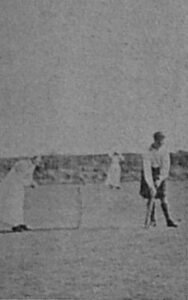 The annual Fete and Sports Day
The annual Fete and Sports Day
In August 1918 Bexhill Observer carried a report of one dual-purpose sporting occasion, V.A.D. Sports At Cooden. “Miss Bennett and the Nurses were indefatigable” and “the convalescent soldiers threw themselves heartily into the event”. The term Sport was interpreted loosely and most were “of a humorous character” including “eating bun and treacle”, “ugly faces” and “humming a tune race” There were various fete stalls with competitions run by nurses and members of their families as well as the patients. The impression is of a thoroughly enjoyable and inclusive community event that had become an established tradition, and successfully raised morale and funds.
Fund Raising
War Office and Red Cross funding only seems to have covered basic necessities and the need to keep donations coming in was incessant. A statement of accounts for 1915 was given in the Bexhill Observer of 29th January 1916. “The £822 6s received from the War Office represents at 3s per day the fact that 5,483 beds have been occupied in the Hospital during the period covered by these amounts”. Therefore various fundraising events and donations were crucial to the continuation of the hospital.
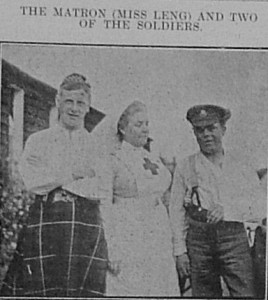 Miss E. M. Willson and Miss N.B. Bennett receive awards.
Miss E. M. Willson and Miss N.B. Bennett receive awards.
Commandants of Cantelupe Road and Cooden Beach Hospitals, were both awarded Membership of the Civil Division of the Order of the British Empire, (MBE), in April 1920.
In Spring 1918 Cooden Training Camp was taken over by Princess Patricia’s Canadian Red Cross Convalescent Hospital which could take 2000 patients. The relationship between Cooden Beach Red Cross Hospital, Sussex 38 VAD and Princess Patricia’s Red Cross Hospital is unclear from the newspaper reports which continue to record the activities of Miss Bennett and Sussex 38 until closure of the hospital in 1919.

